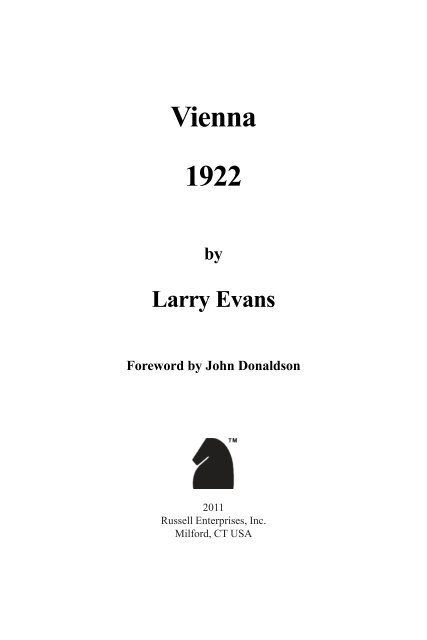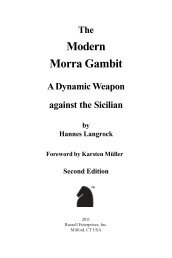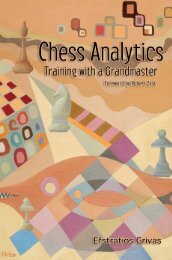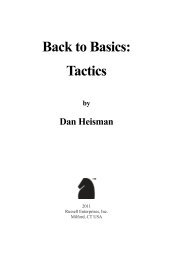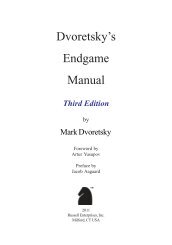Vienna 1922 by Larry Evans - Russell Enterprises, Inc.
Vienna 1922 by Larry Evans - Russell Enterprises, Inc.
Vienna 1922 by Larry Evans - Russell Enterprises, Inc.
You also want an ePaper? Increase the reach of your titles
YUMPU automatically turns print PDFs into web optimized ePapers that Google loves.
<strong>Vienna</strong><br />
<strong>1922</strong><br />
<strong>by</strong><br />
<strong>Larry</strong> <strong>Evans</strong><br />
Foreword <strong>by</strong> John Donaldson<br />
2011<br />
<strong>Russell</strong> <strong>Enterprises</strong>, <strong>Inc</strong>.<br />
Milford, CT USA<br />
1
<strong>Vienna</strong> <strong>1922</strong><br />
<strong>Vienna</strong> <strong>1922</strong><br />
<strong>by</strong><br />
<strong>Larry</strong> <strong>Evans</strong><br />
ISBN: 978-1-936490-02-8<br />
© Copyright 2011<br />
<strong>Larry</strong> <strong>Evans</strong><br />
All Rights Reserved<br />
No part of this book may be used, reproduced, stored in a retrieval system<br />
or transmitted in any manner or form whatsoever or <strong>by</strong> any means, electronic,<br />
electrostatic, magnetic tape, photocopying, recording or otherwise,<br />
without the express written permission from the publisher except in the<br />
case of brief quotations embodied in critical articles or reviews.<br />
Published <strong>by</strong>:<br />
<strong>Russell</strong> <strong>Enterprises</strong>, <strong>Inc</strong>.<br />
P.O. Box 3131<br />
Milford, CT 06460 USA<br />
http://www.russell-enterprises.com<br />
info@russell-enterprises.com<br />
Cover design <strong>by</strong> Janel Lowrance<br />
Photo of <strong>Larry</strong> <strong>Evans</strong> (p.6) courtesy of Ruth Haring<br />
Photo of Vladimir Vukovic courtesy of Jon Edwards<br />
Printed in the United States of America<br />
2
Table of Contents<br />
Foreword <strong>by</strong> John Donaldson 4<br />
Preface 7<br />
<strong>Vienna</strong> <strong>1922</strong> Crosstable 10<br />
Round 1 11<br />
Round 2 18<br />
Round 3 27<br />
Round 4 34<br />
Round 5 43<br />
Round 6 52<br />
Round 7 60<br />
Round 8 71<br />
Round 9 81<br />
Round 10 90<br />
Round 11 100<br />
Round 12 110<br />
Round 13 120<br />
Round 14 128<br />
Round 15 136<br />
Player Index 144<br />
3
<strong>Vienna</strong> <strong>1922</strong><br />
Foreword<br />
<strong>Vienna</strong> <strong>1922</strong> Revisited<br />
<strong>Vienna</strong> <strong>1922</strong> is remembered as one of the first great tournaments after World War<br />
I. All the stars of the day (Alekhine, Bogoljubow, Grünfeld, Maróczy, Réti,<br />
Spielmann, Tarrasch and Tartakover) played except Capablanca and Lasker, but<br />
it was Akiba Rubinstein who was to turn in an outstanding success scoring an<br />
undefeated 11½ from 14 to finish a point and half ahead of second place Tartakover<br />
and two and a half (!) points ahead of Alekhine. This was the same Alekhine who<br />
had been dominating the tournament arena of the early 1920s having taken first<br />
place at The Hague, Budapest and Triberg the year before and Hastings a few<br />
months earlier.<br />
Hindsight allows us to know that <strong>Vienna</strong> <strong>1922</strong> was an aberration, that the future<br />
would belong to Alexander Alekhine, but for fans of the great Rubinstein this was<br />
one last chance to dream that he might yet battle for the world championship title.<br />
Certainly his victories over Alekhine (the last of his career), Bogoljubow (which<br />
won the first brilliancy prize) and Spielmann compare with the best games he<br />
ever played. Every tournament winner needs a little luck and Rubinstein used his<br />
to save a difficult and theoretically important ending against his compatriot<br />
Tartakover in what proved to be the crucial game in the battle for first place.<br />
<strong>Vienna</strong> <strong>1922</strong> will also be remembered as the greatest result in the career of the<br />
Austrian master Heinrich Wolf who finished an outstanding third with 10 points,<br />
beating both Alekhine and Bogoljubow. The journeyman master Wolf, who was<br />
to perish at the hands of the Nazis in 1943, played in many other international events<br />
in his career but with nothing resembling the success he enjoyed at <strong>Vienna</strong> <strong>1922</strong>.<br />
The influence of the Hypermoderns was felt in this event. While the participants<br />
opened overwhelmingly with 1.e4 and 1.d4, the Nimzo-Indian, Grünfeld (featuring<br />
a win <strong>by</strong> the creator of this opening with his favorite weapon against Alekhine)<br />
and Alekhine all saw action. Curiously, while four games opened 1.e4 Nf6, none<br />
featured Alekhine either as Black or White.<br />
Many famous chess writers were in attendance at <strong>Vienna</strong> <strong>1922</strong>. Alekhine,<br />
Tartakover, Tarrasch and Réti are remembered as not only great players but also<br />
for their literary contributions to the game. While no one would ever compare<br />
Vladimir Vukovic and Imre König as players to this illustrious group their classic<br />
works The Art of Attack and From Morphy to Botvinnik, are still read with benefit<br />
<strong>by</strong> chess players today.<br />
<strong>Vienna</strong> <strong>1922</strong> was the international debut for König, who was studying in <strong>Vienna</strong><br />
at the time and, at 21, was the youngest player in the tournament. This writer had<br />
the honor of talking with König at his home in Santa Monica, California in 1990.<br />
4
Foreword<br />
A gentlemen of the old school with a sharp sense of humor, König’s memory was<br />
still sharp in his 90s. He vividly recalled the pleasures and distractions of studying in<br />
<strong>Vienna</strong> in the 1920s when the famous coffeehouse culture was still going strong.<br />
The author of this work, <strong>Larry</strong> <strong>Evans</strong>, is best remembered today for his books and<br />
columns and serving as Bob<strong>by</strong> Fischer’s second, but his abilities as a player should<br />
not be forgotten. A junior talent when they were not nearly as common as today,<br />
<strong>Evans</strong> finished in the middle of the field (10th place with 11 from 19) in the 1948<br />
U.S. Championship, the year this book was written. Two years later he would<br />
make his debut for the United States in the 1950 Olympiad at Dubrovnik, scoring<br />
an excellent 8 from 9 (tied for the best result in the event with Rabar) less than a<br />
month after being in a serious automobile accident. The next three decades <strong>Evans</strong><br />
would be a regular member of the U.S. national team and would win the U.S.<br />
Championship five times.<br />
This book marked the beginning of what turned out to be one of the longest and<br />
most productive literary careers in American chess history. A complete list of all<br />
of grandmaster <strong>Larry</strong> <strong>Evans</strong>’ contributions would require a small book but one<br />
can mention his co-authoring My Sixty Memorable Games with Bob<strong>by</strong> Fischer,<br />
his revision of MCO-10, his magazine American Chess Quarterly and his longrunning<br />
column in Chess Life as some of the highlights.<br />
John Donaldson<br />
Berkeley, California<br />
October 2010<br />
Publisher’s Note<br />
This was the first book ever written <strong>by</strong> American grandmaster <strong>Larry</strong> <strong>Evans</strong>. The<br />
then 16-year-old master self-published it in 1948 with English descriptive notation,<br />
no diagrams, with a plastic ring binding, mimeographed. In early 2010, when<br />
we contacted <strong>Larry</strong>, he was persuaded to revise and update it, making use of<br />
modern figurine algebraic notation, and many diagrams, not to mention annotations<br />
that have made him one of the most popular chess writers of our era.<br />
Just when this book was being prepared to go to press, however, the tragic news<br />
flashed around the world: <strong>Larry</strong> <strong>Evans</strong> had died. As far as chess in America was<br />
concerned, he had been a national treasure. But his loss was not felt only in the<br />
U.S. He was admired as a chessplayer, journalist and author worldwide.<br />
As noted <strong>by</strong> John Donaldson in his Foreword, this book marked the beginning of<br />
what turned out to be one of the longest and most productive literary careers in<br />
American chess history. It also tragically turned out to be <strong>Larry</strong>’s swan song. It is<br />
unlikely that the chess world will ever see another chessplayer who accomplished<br />
so much both with the pieces and with the pen.<br />
5
Round 3<br />
While König holds Tarrasch to a draw,<br />
Réti equalizes effortlessly against<br />
Spielmann, also drawing. Rubinstein<br />
turns in a great effort against Bogoljubow<br />
in a game that will be awarded the First<br />
Brilliancy Prize. Tartakower notches another<br />
win, and Alekhine, Wolf and<br />
Maróczy also gather the full point.<br />
Vukovic has the <strong>by</strong>e.<br />
After three rounds, Tartakower has yet<br />
to lose or draw and maintains his halfpoint<br />
lead over Rubinstein, Maróczy<br />
and Alekhine. At the other end of the<br />
crosstable, both Takács and Kmoch are<br />
still looking to put some kind of score<br />
in the plus column.<br />
(15) König – Tarrasch<br />
QGD, Tarrasch [D34]<br />
A series of wholesale exchanges executed<br />
with masterly precision.<br />
1.d4 d5 2.c4 e6 3.Nc3 c5<br />
Tarrasch essays the Tarrasch Defense!<br />
4.cxd5 exd5 5.Nf3 Nc6 6.g3 Nf6<br />
7.Bg2 Be7<br />
Preferring rapid development to<br />
7...cxd4 8.Nxd4 Qb6 9.e3 Bg4<br />
10.Qa4.<br />
8.0-0 0-0 9.dxc5 Bxc5<br />
More enterprising (but no better) is<br />
9...d4 10.Na4 Bf5.<br />
10.Na4<br />
Round 3<br />
27<br />
Siegbert Tarrasch<br />
Instead of decentralizing a piece, it’s<br />
better to exert more pressure on d5 with<br />
10.Bg5 Be6.<br />
10...Be7 11.Be3 Ne4 12.Rc1<br />
Be6 13.Nd4 Nxd4 14.Bxd4 Qa5<br />
cuuuuuuuuC<br />
{rDwDw4kD}<br />
{0pDwgp0p}<br />
{wDwDbDwD}<br />
{1wDpDwDw}<br />
{NDwGnDwD}<br />
{DwDwDw)w}<br />
{P)wDP)B)}<br />
{Dw$QDRIw}<br />
vllllllllV<br />
15.a3<br />
Alekhine-Euwe, match game 1927 continued<br />
15.f3 Nf6 16.Nc5 Qxa2<br />
17.Nxe6 fxe6 18.Bh3 Qa6 19.Qd3<br />
Qd6 20.Qe3 Kf7 and Black holds.
15...Rac8 16.Nc3 Nxc3 17.Bxc3<br />
Qb5<br />
cuuuuuuuuC<br />
{wDrDw4kD}<br />
{0pDwgp0p}<br />
{wDwDbDwD}<br />
{DqDpDwDw}<br />
{wDwDwDwD}<br />
{)wGwDw)w}<br />
{w)wDP)B)}<br />
{Dw$QDRIw}<br />
vllllllllV<br />
18.Qd4<br />
With this maneuver White dissipates<br />
whatever opening advantage that he<br />
might have had. A better try is 18.Qd2<br />
Rc6 19.Rfd1.<br />
18...Bf6 19.Qxa7 Bxc3 20.bxc3<br />
Ra8 21.Qd4 Rxa3 22.Rb1 Qxe2<br />
23.Bxd5 Bxd5 24.Qxd5 Rxc3<br />
25.Qxb7 ½-½<br />
(16) Rubinstein – Bogoljubow<br />
Grünfeld Defense [D94]<br />
This game was strangely awarded the<br />
First Brilliancy Prize.<br />
1.d4 d5 2.c4 c6 3.e3 Nf6 4.Nc3 g6<br />
5.Nf3 Bg7 6.Be2 0-0 7.0-0<br />
Nbd7<br />
Better was 7...dxc4 and 8...Nbd7 keeping<br />
eventual freeing moves like ...c5<br />
and ...e5 in hand.<br />
8.cxd5! Nxd5 9.Nxd5 cxd5<br />
10.Qb3<br />
<strong>Vienna</strong> <strong>1922</strong><br />
28<br />
Puts lasting pressure on the queenside<br />
and prepares speedy occupation of the<br />
c-file.<br />
10...Nf6 11.Bd2 Ne4<br />
cuuuuuuuuC<br />
{rDb1w4kD}<br />
{0pDw0pgp}<br />
{wDwDwDpD}<br />
{DwDpDwDw}<br />
{wDw)nDwD}<br />
{DQDw)NDw}<br />
{P)wGB)P)}<br />
{$wDwDRIw}<br />
vllllllllV<br />
My preference now would be 12.Bb4<br />
to preserve the two bishops.<br />
12.Rfd1 Nxd2<br />
A better bid for freedom is 12...Bg4,<br />
inviting 13.Qxb7?! Rb8 14.Qxa7<br />
Rxb2.<br />
13.Rxd2 Qd6 14.Rc1 b6<br />
14...Rb8 could have been tried to avoid<br />
weakening the queenside, but Black’s<br />
already in trouble.<br />
15.Rdc2 Bb7 16.Qa4<br />
A good move. Among other things it<br />
prevents Black’s a8-rook from moving.<br />
16...a6 17.Rc7 b5 18.Qa5 Rab8<br />
19.R1c5 Rfd8 20.Ne5 Bf6<br />
Not 20...Bxe5? 21.dxe5 Qxe5 (or<br />
21...Qe6 ) 22.Rxb7! and wins. But<br />
White already has a decisive advantage.
21.Nc6 e6<br />
cuuuuuuuuC<br />
{w4w4wDkD}<br />
{Db$wDpDp}<br />
{pDN1pgpD}<br />
{!p$pDwDw}<br />
{wDw)wDwD}<br />
{DwDw)wDw}<br />
{P)wDB)P)}<br />
{DwDwDwIw}<br />
vllllllllV<br />
The point. After 22.Nxb8 Rxb8<br />
(threatening.Bd8 which regains the<br />
exchange) but 23.Bxb5! Bd8 24.Be8<br />
still wins.<br />
22.g3! Rdc8 23.Nxb8 Rxb8<br />
24.Bxb5! Bd8<br />
If instead 24...axb5, then 25.Qa7 etc.<br />
25.Be8! Qf8<br />
25...Bxc7 is obviously no better.<br />
26.Rxb7! Bxa5 27.Rxb8 Qd6<br />
28.Bxf7+ was threatened.<br />
28.Rb7 Bb6 29.Rc6 Qb4<br />
30.Bxf7+ 1-0<br />
(17) Tartakower – Grünfeld<br />
<strong>Vienna</strong> Game [C26]<br />
A swindle in Tartakower’s finest style.<br />
1.e4 e5 2.Nc3 Nf6 3.g3 d5 4.exd5<br />
Nxd5 5.Bg2 Be6<br />
Tartakower-Spielmann, <strong>Vienna</strong> 1913<br />
continued 5...Nxc3 6.bxc3 Bc5 7.Ne2<br />
Round 3<br />
29<br />
Nc6 8.0-0 0-0 9.d3 Be6 with an equal<br />
position. The text is also okay..<br />
6.Nge2 Nc6<br />
6...c5 is more energetic, aiming for a<br />
Maroczy Bind in reverse.<br />
7.d4<br />
Better is 7.d3 Be7 8.0-0 0-0 9.f4 exf4<br />
10.Nxf4 with equality. Black now<br />
stands well, but he misses his way.<br />
7...Nxc3 8.Bxc6+ bxc6 9.bxc3<br />
Qd5!<br />
cuuuuuuuuC<br />
{rDwDkgw4}<br />
{0w0wDp0p}<br />
{wDpDbDwD}<br />
{DwDq0wDw}<br />
{wDw)wDwD}<br />
{Dw)wDw)w}<br />
{PDPDN)w)}<br />
{$wGQIwDR}<br />
vllllllllV<br />
The doubled pawns are more than compensated<br />
for <strong>by</strong> White’s weakness on<br />
the light squares, and his inability to<br />
castle because of ...Bh3.<br />
10.Rg1 Bd6 11.Qd3 0-0 12.dxe5<br />
Qxe5 13.Bf4 Qa5 14.Bxd6 cxd6<br />
If 15.Qxd6 Rfe8 is devastating.<br />
15.Nd4 Bd7 16.Kd2 Rfe8<br />
17.Rge1 Qh5 18.h4 Qh6+<br />
My experience has been that it pays to<br />
take advantage of the lull with a move<br />
like 18...g6 to prevent any back rank<br />
mates once and for all.
19.f4 Qf6<br />
Pointless. Better is 19...Qh5. Now<br />
swapping rooks helps White save the<br />
game.<br />
20.Rxe8+ Rxe8 21.Re1 Rxe1<br />
22.Kxe1 h6 23.Kd2 c5 24.Nb5<br />
Bxb5 25.Qxb5 Qg6?<br />
cuuuuuuuuC<br />
{wDwDwDkD}<br />
{0wDwDp0w}<br />
{wDw0wDq0}<br />
{DQ0wDwDw}<br />
{wDwDw)w)}<br />
{Dw)wDw)w}<br />
{PDPIwDwD}<br />
{DwDwDwDw}<br />
vllllllllV<br />
This allows White to get a dangerous passed<br />
pawn on the queenside. Simply 25...g5 or<br />
even 25...Qe7 holds the balance.<br />
26.Qb8+ Kh7 27.Qxa7 Qxg3<br />
28.Qxf7 Qxh4 29.a4 Qh2+<br />
30.Kc1 Qh1+ 31.Kb2 Qe4<br />
32.Qd7<br />
cuuuuuuuuC<br />
{wDwDwDwD}<br />
{DwDQDw0k}<br />
{wDw0wDw0}<br />
{Dw0wDwDw}<br />
{PDwDq)wD}<br />
{Dw)wDwDw}<br />
{wIPDwDwD}<br />
{DwDwDwDw}<br />
vllllllllV<br />
Black has tossed away a big advantage.<br />
Now if 32...Qxf4, 33.Qb5! followed <strong>by</strong><br />
a5 wins.<br />
<strong>Vienna</strong> <strong>1922</strong><br />
30<br />
32...h5 33.a5 Qa8 34.f5 Kg8<br />
Also hopeless is 34...Qxa5 35.f6. This is<br />
one game that Black can’t be proud of.<br />
35.Qb5 h4 36.a6 Qg2 37.a7 1-0<br />
(18) Spielmann – Réti<br />
<strong>Vienna</strong> Game [C29]<br />
Black easily equalizes.<br />
1.e4 e5 2.Nc3 Nf6 3.f4 d5 4.fxe5<br />
Nxe4 5.Nf3 Be7<br />
A good alternative is 5...Bb4.<br />
6.d4 0-0 7.Bd3 f5 8.exf6 Bxf6<br />
Also playable is 8...Nxf6 9.0-0 Nc6<br />
10.Bg5 Bg4 as in Spielmann-Maróczy,<br />
Teplitz-Schönau <strong>1922</strong>.<br />
cuuuuuuuuC<br />
{rhb1w4kD}<br />
{0p0wDw0p}<br />
{wDwDwgwD}<br />
{DwDpDwDw}<br />
{wDw)nDwD}<br />
{DwHBDNDw}<br />
{P)PDwDP)}<br />
{$wGQIwDR}<br />
vllllllllV<br />
The only try for an advantage is 9.Nxe4<br />
dxe4 10.Bxe4 Re8 11.Qe2 Bf5<br />
12.Nxf6+ gxf6 13.Be3 Bxc2 14.Qxc2<br />
Rxe3+ 15. Kf2.<br />
9.0-0 Nc6 10.Nxe4<br />
At Berlin 1926, Spielmann against von<br />
Holzhausen played 10.Ne2 Nb4!<br />
11.Bb5 Bd7 12.Bxd7 Qxd7 and Black<br />
equalized.


